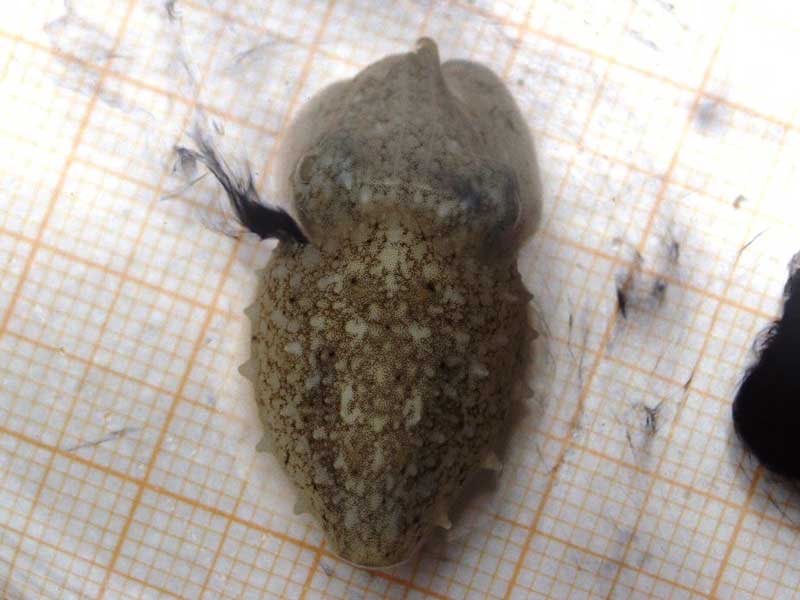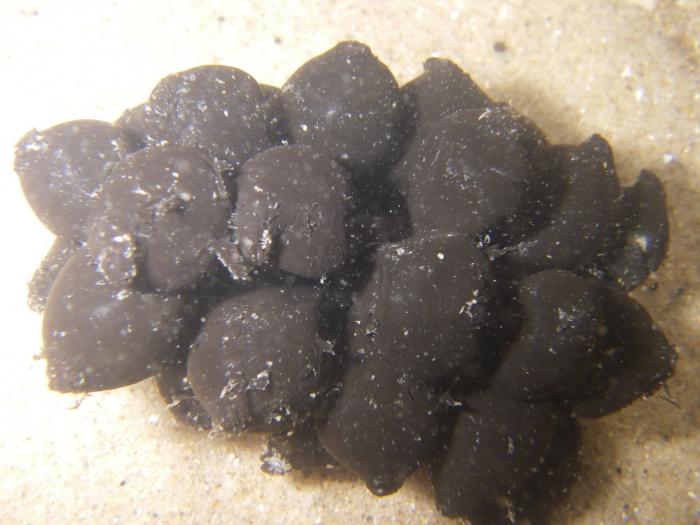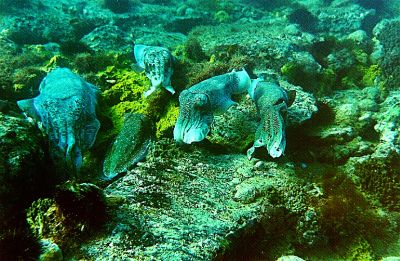Interactions with Other Species
Cuttlefish usually swim alone, but they are known to swim with up to six other cuttlefish (Ikeda 2009). A school of fish outnumbers a single cuttlefish, therefore, a school of fish could act as competitor. They act as competition to the cuttlefish because the school of fish scares away or consumes the cuttlefishes' possible prey (Langridge 2009).
PREY
Cuttlefish usually prey on crustaceans, like the
dungeness crab,
snow crab or the
white shrimp, but sometimes they will prey on a few different
species of fish (Blanc et al. 1998). When a cuttlefish pursues its
prey, it usually attacks within one minute (Darmaillacq et al.
2008). Thus, within that one minute the cuttlefish may use a
technique to stun its prey. This technique involves flashing the
color of its skin while waving its
arms and making itself appear
larger. The prey is mesmerized by this appearance
and they become immobilized and helpless (NOVA 2007).
PREDATORS
Predators of cuttlefish include fish,
sharks,
seals, and even other cuttlefish (Langridge,
2009)!  Cuttlefish have soft bodies which make them vulnerable
to predators, therefore, cuttlefish have several visual displays
that protect them. One of the displays is called the deimatic
display. The deimatic display is performed by many species across
the animal kingdom. It consists of the sudden expression of dark
spots that resemble eyes, and the enlargement of their body to look
threatening (Langridge 2009). They enlarge their body by sucking
water into their mantle cavity and
spreading their arms (NOVA 2007). Another visual display is
their
camouflage. Cuttlefish have body-patterning techniques that allow
them to blend into their surroundings so they can avoid being caught
by predators (Ikeda 2009). However, if the visual displays fail to
warn off a predator, and the enemy gets too close, the cuttlefish
will jet ink and disrupt the view of the predator, then make a quick
getaway (Langridge 2009).
Cuttlefish have soft bodies which make them vulnerable
to predators, therefore, cuttlefish have several visual displays
that protect them. One of the displays is called the deimatic
display. The deimatic display is performed by many species across
the animal kingdom. It consists of the sudden expression of dark
spots that resemble eyes, and the enlargement of their body to look
threatening (Langridge 2009). They enlarge their body by sucking
water into their mantle cavity and
spreading their arms (NOVA 2007). Another visual display is
their
camouflage. Cuttlefish have body-patterning techniques that allow
them to blend into their surroundings so they can avoid being caught
by predators (Ikeda 2009). However, if the visual displays fail to
warn off a predator, and the enemy gets too close, the cuttlefish
will jet ink and disrupt the view of the predator, then make a quick
getaway (Langridge 2009).
![By Schellack at en.wikipedia [Public domain], from Wikimedia Commons](Linguine_with_cuttlefish.jpg)
Humans can also be seen as a threat because they capture cuttlefish to eat. For example, the picture to the left is apopular italian dish, linguine with cuttlefish and cuttlefish ink sauce.
LEARNING ABILITIES
Cuttlefish have learning abilities which give it an advantage over
other species (Ikeda 2009). In fact, even as embryos they are being
visually imprinted with how their prey looks and how it acts.
Therefore, once the baby cuttlefish hatch, they know what their food
looks like, and how to find it without the help of a parent (Ikeda
2009).

INTERSPECIES COMMUNICATION
Cuttlefish are known to have a variety of interspecies
communication. They use body-patterning techniques, they emit
chemical odors, and respond to vibrations of the water surrounding
them (NOVA 2005). It is thought that the chemical communication is
connected with reproductive behavior (NOVA 2005).
Now check out the interesting facts page!
![By Parent Géry (Own work) [Public domain], via Wikimedia Commons](travelportal/images/newheader.jpg)
